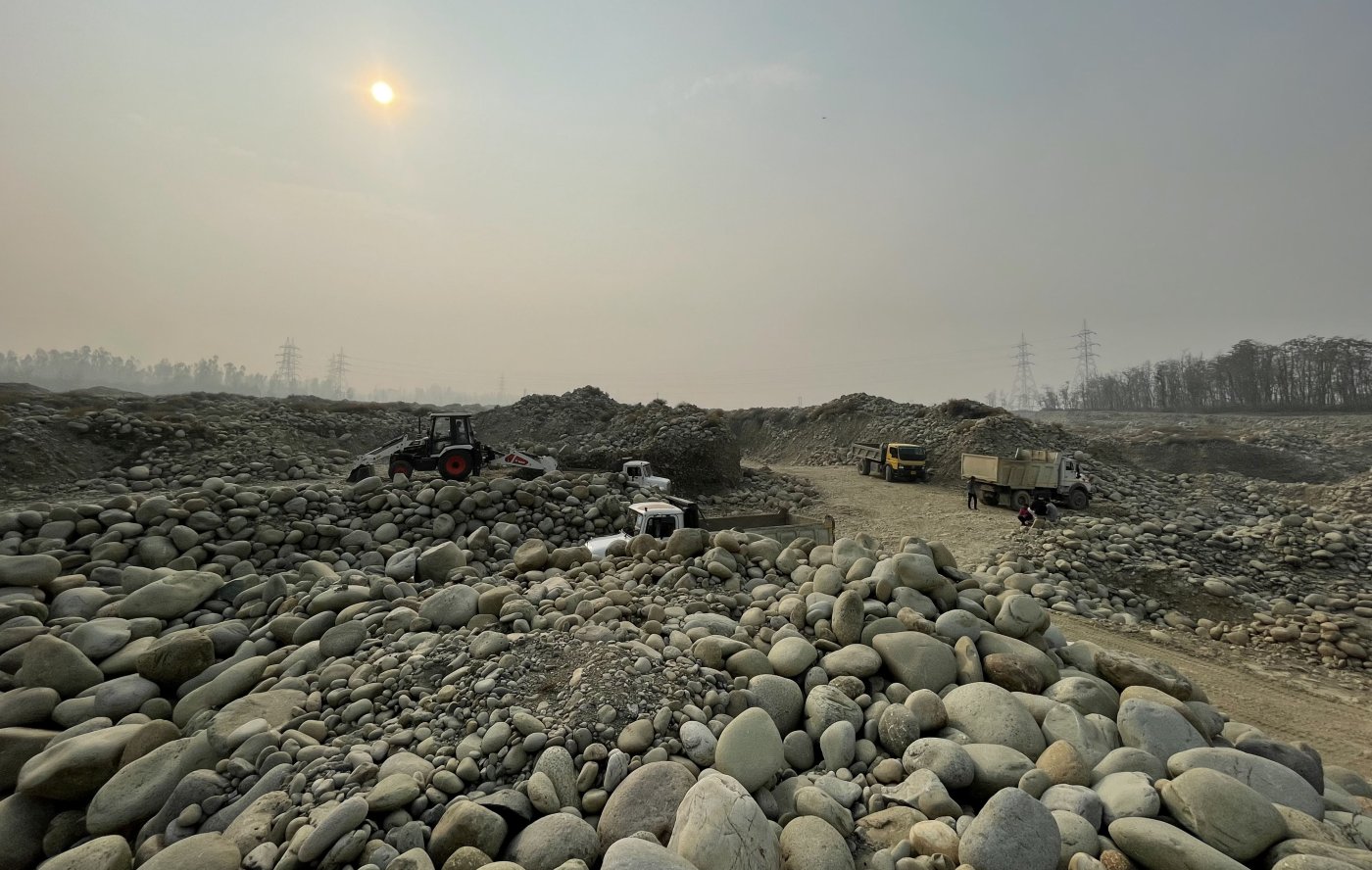Srinagar: When flash floods triggered by a cloudburst in the upper reaches of Kashmir's Kulgam district, approximately 68 km south of Srinagar, ravaged villages on 22 July 2023, among the thousands who experienced destruction of homes and farmlands was Zahoor Dar, 51.
Dar was a resident of Mallbagh Korel, a village with a habitation of only 15 families. Located a few kilometres from the banks of the Vishaw river, a tributary of the Jhelum, Korel faced the full force of the floods.
Dar was working in his apple orchard when he saw a massive surge of muddy water heading towards Korel. Dar rushed home to warn his wife and five children.
“I left the orchard, got my family, and moved them to the elevated main road nearby,” Dar said. “As the water swept through my house and orchard, it felt like doomsday.”
Dar’s two-storey house suffered minor damages, and stacks of bricks and wood he had arranged for renovation work were swept away. The “real hit” was taken by the orchard, he said.
He estimated the damages at Rs 200,000, equivalent to his yearly earnings from sale of apples, his only source of income. After the flood, Dar began to work as a daily wage labourer, in an attempt to make up for the losses.
It was the first time that a flash flood caused such extensive damage in Korel, locals said.
“For others, it may have been just another natural calamity, but for us, it was a man-made crisis,” Dar said. “It happened because of miners in the Vishaw river.”
Mining in riverbeds and riparian areas is usually for the extraction of sand, boulders and gravel, all used in the construction industry, a growing sector that contributes nearly 8% of India’s GDP.
Across India, illegal and unregulated river-bed mining for sand and other minerals has had environmental fallouts, including changes in river morphology, riverbank erosion and water pollution, posing grave hazards to local communities (see here, here, here and here).
Data provided by the Jammu & Kashmir government on annual sand and riverbed mining bears out citizens’ accounts of a massive intensification of mining operations in recent years.
In 2021-22, leaseholders mining riverbeds for sand and minor minerals extracted 4.74 lakh tonnes of material from 37 blocks where leases were given. In 2022-23, the quantity of material mined from riverbeds more than doubled over the previous year, with 11.42 lakh metric tonnes of sand and minor minerals extracted from 72 blocks where leases were given.
A very steep overall rise in mineral production in Kashmir, from 60 lakh metric tonnes in 2021-22 to 121 lakh metric tonnes in 2022-23 was attributed to a surge in demand to feed local construction and the massive infrastructure projects being undertaken in the Valley.
The annual 2022-23 report by the directorate of geology and mining of the government of Jammu & Kashmir cited the widening of national highways, construction of a ring road, the Delhi-Katra expressway, railway works, projects by the Border Roads Organisation, the Pradhan Mantri Gram Sadak Yojana for rural roads, the prestigious project to erect an All India Institute Of Medical Sciences in Kashmir as the chief reason why demand for minor minerals and building materials has “enormously” increased. The report acknowledged that these activities had “imposed immense pressure on rivers”.
Despite repeated requests for meetings and interviews with the administrative secretary of the mining department, Article 14 was unable to get a response from the secretary's office to citizens’ grievances with illegal mining.
Article 14 also contacted the director, geology and mining department, but received no response despite repeated attempts. The member secretary of the J&K environment impact assessment authority also did not respond to requests for a comment.
Authorities have, however, acknowledged on multiple occasions that illegal sand mining is a growing threat (see here, here, here). In 2022-23, authorities seized as many as 6,909 vehicles involved in illegal extraction and transportation of minerals in the union territory, imposing penalties totalling more than Rs 16 crore on illegal miners.
A ‘Plague’ Descends On Korel
The cloudburst was one reason for the flash floods that devastated Korel village, but major damage also stemmed from illegal and unregulated riverbed mining.
The Jhelum’s meandering course from a deep spring in western Jammu & Kashmir through the Pir Panjal range runs over 700 km in the union territory and in neighbouring Pakistan. Perennial rivers that form left and right bank tributaries of the Jhelum deposit huge quantities of riverbed minerals such as sand (silica), boulders and bajri (riverbed sand) along their courses and in the floodplains. These are extracted for use as material in the construction industry in Kashmir.
Several local residents called the extraction of riverbed materials a “plague” on Kashmir's rivers. The situation in Korel village highlighted challenges faced by riverside communities across much of the Kashmir valley.
At several locations along the Jhelum, its tributaries and minor streams, the mining violates several stipulations of the Jammu and Kashmir Minor Mineral Concession, Storage, Transportation Of Minerals And Prevention Of Illegal Mining Rules, 2016, including its limit of 3 metres from the base of the water level for riverbed mining, its prohibition of mining within 25 metres of river embankments, its advisory against use of heavy machinery and its prohibition of night-time mining operations. environmental rules, such as mining Depth Limits, proximity to river embankments and use of heavy machinery, miners started using heavy excavator machines and earthmovers to extract minerals from the rivers.
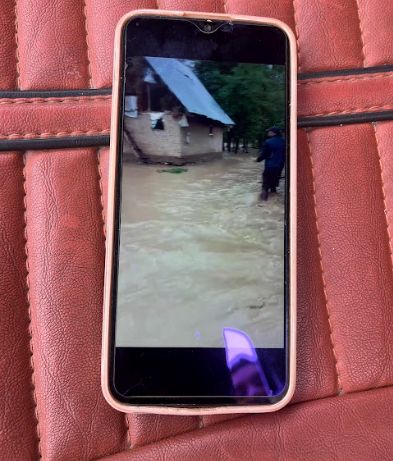
Dar said miners began to first use machines along the Vishaw riverbed in 2019. “... they began mining day and night,” he recalled. “After ravaging it for three years, they shifted their focus to our village.”
Dar was referring to mining using excavators in what locals call “jungle nallah”, a small stream that runs through Korel. The stream that had always been an irrigation canal for the village has become a source of boulders for the construction industry since 2022.
According to villagers, the flash flood waters flowed out of Korel through the same stream.
Dar said the river and the stream had witnessed surges before, but the embankment of the stream had always prevented water from severely inundating homes and farmlands.
Dar, who recorded videos of the 22 July flash floods on his mobile phone, said the embankment along the stream, once 6 feet to 7 feet in height, had reduced since the excavation of boulders began. “When the floods struck, there was nothing to hold the water,” he said. “The embankments were already gone.”
Some of what was left of the embankment was further damaged and eroded by the flood. Dar said had the embankment not been destroyed, damages to Korel’s people would have been significantly lower, and his orchard may not have faced as much destruction.
At least 10 families in Korel, all of them chiefly dependent on their orchards for income, felt the impact of the mining along the jungle nallah. Most of these families, with no other means of sustenance, began to work as day wage workers after the flood. They all blame illegal mining for the destruction from the flood.
Mushtaq Ahmed Bhat, 52, incurred losses worth Rs 4 lakh on 22 July when his orchard was ravaged by the flood. “When miners first came, they used only one bulldozer,” said Bhat. After a few days, he saw more heavy machines extracting boulders from the stream. “It was so aggressive that our houses would literally shake”.
Villagers found the water supply from the stream inadequate for spraying pesticides and fertiliser in 2022, leading to a lower yield that season. Before machines were introduced for mining in the stream, the water followed a single path through Korel. With new channels opened up on account of excavation of sand and boulders, much of the water had begun to flow into areas without vegetation, said local residents.
“It's absurd to extract material from a small stream, isn't it?” Mushtaq Ahmed Bhat said.
Villagers Feel Impact Of Excessive Mining
According to Rule 4 of the Jammu and Kashmir Minor Mineral Concession, Storage, Transportation of Minerals and Prevention of Illegal Mining Rules, 2016, mining is prohibited within 25 metres of river or stream embankments. Korel’s villagers claimed, however, that the total width of the jungle nallah is no more than 8 metres.
Objecting to illegal and unregulated mining can be dangerous, the villagers found.
Mushtaq Ahmed Bhat said villagers tried to stop the excavation, approaching excavator drivers and their accompanying supervisors. “We were given an ultimatum: either let them continue mining or our entire family would be sent to central jail.” Bhat said villagers fell silent after that.
The flash floods devastated Bhat's orchard so much that his apple trees may not yield anything soon. The still-developing fruit was destroyed in July 2023, and the trees, having lost much of their foliage, are unlikely to flower in the coming season. “This stream was a source of our livelihood,” said Bhat, father of three. “Now, it has become a reason for our miseries.”
An environmentalist in Kashmir explained that excessive extraction of riverbed material including boulders leaves riverbanks exposed. An intact boulder bed offers some resistance to water, determining its normal course. Removing the boulders can turn any normal river flow into a storm surge, capable of reaching elevated areas and causing more damage.
According to a 2021-22 report by the Jammu & Kashmir(J&K) government’s geology and mining department, 247 ‘minor mineral blocks’ or areas demarcated for mining activities were prepared in various streams and rivers of Kashmir valley, and 224 of these were e-auctioned.
For sustainable mining in such blocks, a 2016 notification from the Union ministry of environment, forest & climate change (MoEFCC) made it mandatory for miners to obtain an environmental clearance (EC) from competent authorities before undertaking mining activities. Mining work is assessed for every block auctioned, and the union government-appointed State Environment Impact Assessment Authority (SEIAA) issues the EC.
In order to obtain an EC, a project proponent must adhere to a set of guidelines that are listed in the granted EC itself. One such guideline from an EC issued for mining in the Vishaw said, “Mining shall be done manually minimally supported by semi-mechanized methods. Heavy machinery like JCBs, Excavators, L&T hydraulic excavators etc should not be allowed.”
However, in violation of the rules governing the EC, mining work using bulldozers, dumper trucks, tippers and crawler excavators is currently underway in many of the major tributaries of the Jhelum, including the Rambiara river in Pulwama and Shopian in south Kashmir, the Vishaw river in Kulgam, and the Sukhnag river in central Kashmir’s Budgam.
The rampant mining has vandalised river ecosystems and changed the hydrology of rivers, according to people living in their vicinity.
“There were 12 springs in our village. Since bulldozers and other excavators started mining the Rambiara river, all these have run dry,” said Mohammed Khaleel Bhat, a resident of Panjran village in Pulwama. The village has faced a water scarcity in recent years.
He said that in many areas, the embankments along the river have disappeared, flow has decreased as water slips away through new channels and the riverbed has developed massive craters where machines excavated material.
According to rule 4.3 of Jammu and Kashmir Minor Mineral Concession, Storage, Transportation of Minerals and Prevention of Illegal Mining Rules, 2016, “no mining activity/operation shall be carried out in any river bed below the depth of 3 metres or below the water level, whichever is lesser.” On the ground, however, this rule is being barely implemented, saud villagers.
Raja Muzaffar Bhat, an independent environmental and Right to Information (RTI) activist, told Article 14 that illegal and excessive riverbed mining has eroded the flood mitigation capabilities of Kashmir’s rivers.
“Once tall, the embankments now have caves like structures due to deep mechanised mining,” he said. “This has made them porous and, in some places, completely destroyed.” He said this resulted in an increased risk of flooding, landslides and soil erosion, posing a permanent threat to vegetation around rivers.
Raja Muzaffar Bhat added that before mechanised mining began, rivers followed a set course, nourishing paddy fields, apple orchards and vegetable farms through small irrigation channels. Mining that may reach depths of 30 feet causes the river level to drop, preventing water from reaching the vegetation and causing farmlands and tubewells to dry up. “This could spill massive trouble for Kashmir,” he said.
A 2022 study on the socio-economic and environmental implications of mining operations in the Jhelum in north-western Kashmir’s Himalayan region found that extraction of riverbed materials in upstream regions changes the river’s morphology and disturbs the balance of its channels.
“Digging and unceasing amputation of sand and boulders steadily enlarges the size of pits which eventually reach towards the banks causing them to collapse,” the study said. As a result, river banks recede, and become wider, thereby modifying the river’s morphological and hydrological conditions.
Threat To Villages, Food Security
In central Kashmir's Budgam, 32-year-old Mushtaq from Sail village converted his paddy field into an apple orchard when the miners in the Sukhnag river shifted from manual mining to using heavy machines. Mushtaq wanted to be identified by his first name only.
Paddy cultivation requires an abundant supply of water, which the region usually enjoyed on account of its proximity to the Sukhnag. “When miners brought in machines, however, the river level reduced by more than 25 feet,” he said, “and subsequently, my farmland was elevated.” The flow of water became low, and his paddy production fell by about half. He took up horticulture as an alternative about three years ago.
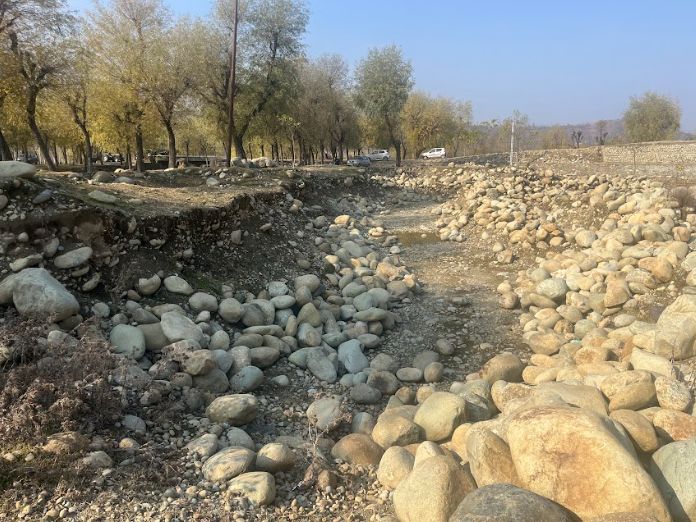
The switch to fruits has not helped, and Mushtaq said he may be forced to sell his land. “Within two or three years, there may not be enough water for even pesticide spraying in the orchards,” he said, adding that eight other paddy fields in Sail village dried up in recent years, all due to water scarcity caused by the riverbed mining.
With such fallouts, experts have said the large scale unregulated mining will have serious implications on the Kashmir valley's food security. “River excavation is an essential part of managing and controlling the river hydrology,” said one expert climatologist, requesting to remain anonymous. “In Kashmir, the mining, whether legal or illegal, is being done unscientifically.”
The expert said rivers were being excavated in places where mining is unnecessary, affecting water sources for villages. The direct consequence was that people with paddy fields had converted these into orchards.
According to experts, mining may create sinkholes in riverbeds, puncture aquifers, hamper natural river systems and affect the parallel subsurface flows that feed small streams and irrigation canals. This is the reason that a rise in mining activities has led to many small streams slowly running dry.
Paddy farmers of Achan village in south Kashmir’s Pulwama district have converted their land into high-density apple orchards that require less water, visible along the former paddy fields near the Rambiara river. Ghulam Mohammed Najar, a village representative, said the government had failed to monitor illegal mining, and villagers who found water under their riverside lands upon digging just 10 feet now cannot find water even at depths of 80 feet. “The mining has brought down the river's level so much that it's hard to find water for drinking, let alone having enough for our fields,” Najar said.
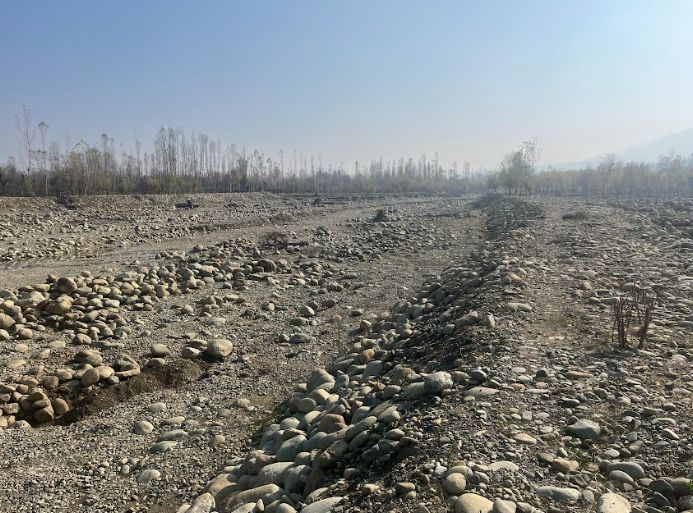
Achan’s residents said most mining activities happen at night and the mined material is carried out by trucks through the village road, disturbing the elderly and the unwell in the early hours of the day.
Mining during the day is on a smaller scale, with only a handful of dumpers and earth-movers, said the people of Achan. “The main mining activity starts at night. Throughout the night, the noise of heavy excavators and earthmovers doesn't let us sleep,” said Abdul Rashid Malla even as a dumper truck rolled through the village road. Over 100 dumper trucks carrying boulders make their way through the village every night, he said.
The nightly operations, reported from other parts of north, south and central regions of the Kashmir valley too, violate two important environmental rules—condition 38 of the SEIAA’s rules for Jammu and Kashmir prohibits mining operations at night, restricting it to daylight hours or between 6 am and 7 pm; and condition 44, which prohibits transportation of minerals through villages.
No Action Despite Open Violation Of Rules
Deep inside the village of Sugan in south Kashmir’s Shopian district, about 2 km from the main road and well out of sight, the roar of bulldozers and the sound of dumper trucks in motion was unmistakable. Seven heavy machines along with a few men were mining in the Rambiara river, violating multiple rules laid down in environmental clearance documents.
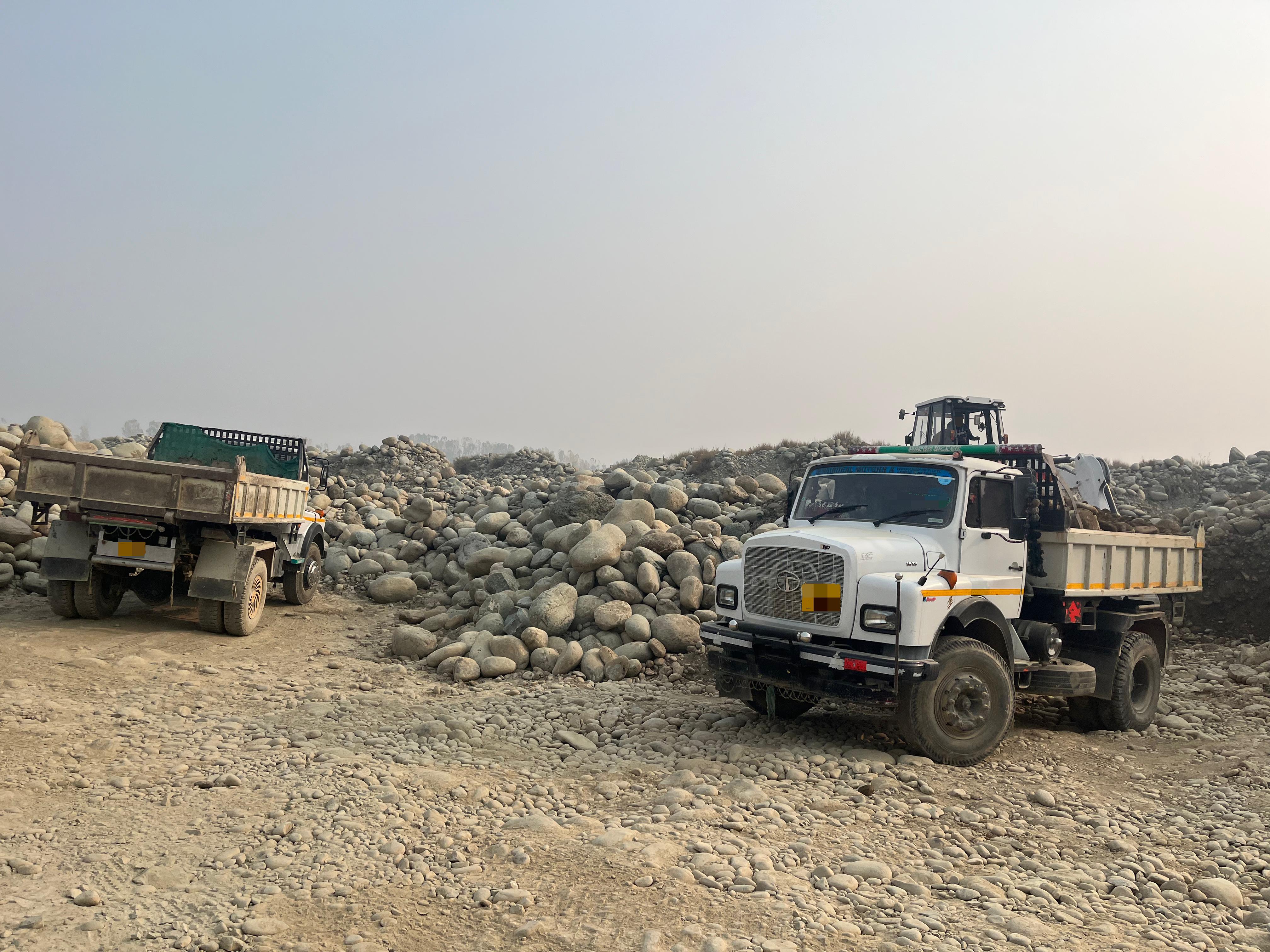
Pointing from one end of the river to where the machines were mining, a local Kashmiri supervisor at the mining site said that mining at night is quite easy “as there are no government officials present on the ground”.
The spot where he and his team were taking materials from the riverbed and loading them on dumper trucks was a deep pit created by extensive mining. The young supervisor said the depth from ground level to the base of the deep pit was 20 feet to 25 feet.
He claimed that his employer held a permit for riverbed mining, but Article 14 could not verify his claim.
He admitted that mining continues through the night at three locations they have permissions for. “Only my group can extract materials from these three points,” he said. “Officials don't really come here at night because they're scared.”
The only hitch they faced was being occasionally halted at checkpoints, where, according to the supervisor, a small cash bribe was usually sufficient to enable them to pass. “We've also constructed a temporary road within the river for our machines. It saves a lot of travel time.”
The site in the Sugan village was not the only one where miners violated the rules. From use of heavy machinery, to mining beyond the demarcated areas and transportation of minerals through villages, these violations were a common sight in areas around the major tributaries of the Jhelum.
Kashmir’s Rivers: The Goose With Golden Eggs
Rule 6 of the Jammu and Kashmir Minor Mineral Concession, Storage, Transportation of Minerals and Prevention of Illegal Mining Rules, 2016 says one prerequisite before granting permission for minor minerals’ extraction is a review of the ‘mining plan’. “The mining plan shall be approved in consultation with the Fisheries, Forest and Irrigation and Flood Control [I&FC] Departments,” the rule says.
An official from the I&FC department said, however, due process was not followed, and mining plans were often approved without consulting them. “The mining department is itself violating the rules,” said an official from I&FC, declining to be identified. A no-objection certificate is sought from the I&FC department for auction of any mining block, and this certificate is simply issued without perusing the mining plan, he said.
The official said the approved quantity of minerals that can be extracted from each block was also largely on paper alone. If a project holder with approvals to extract 100 trucks of material per day also mines another 100 truckloads of material at night, this may go unchecked. The loophole in implementation and enforcement of rules makes miners see Kashmir's rivers “as a goose laying golden eggs”, he said.
The National Green Tribunal (NGT) also took note of these violations. On 28 November 2023, the NGT issued notices to the J&K Environment Impact Assessment Authority and to the district magistrate of Pulwama regarding violation of conditions laid down while issuing an environmental clearance earlier in the year. The notices were issued in a case regarding illegal riverbed mining in the Romshi nallah in south Kashmir's Pulwama, and pertained to complaints of mining outside the prescribed area, use of heavy machinery and mining within active water channels.
In October 2023, an NGT bench imposed a Rs 35-crore penalty on the J&K government for its failure to control pollution and illegal mining in Doodhganga, a major tributary of the Jhelum, and Mamath Kull, a stream. According to the NGT bench, there were “serious lapses” in waste management on the part of the administration and failure “to control illegal mining which has resulted in huge damage to the environment and public health”.
With such violations going on and in the absence of a proper regulatory mechanism, activists and experts warned that the uncontrolled riverbed mining in Kashmir hasn’t only impacted Kashmir’s local population and their livelihoods but also posed an alarming threat to the valley's aquatic life. Rivers naturally use natural flow systems to assess and dilute freshwater pollutants. “Unfortunately, mining in many rivers has damaged this, and the first impact is on aquatic life,” said the expert.
According to an official from J&K fisheries department, the approval by the fisheries department for a mining plan is always in consideration that the expected impact on aquatic life is minimal. “When mining starts, however, it happens in a completely different zone, mostly fish-rich areas,” said the official, asking not to be identified. “From time to time, the department has written to several deputy commissioners informing them about such violations in their respective districts.” He said no action was ever taken.”
The unabated mining has damaged aquatic life and, particularly, the population of the schizothorax species of fish that are native to Kashmir, locally called the Kaeshir Gaad, popular in Kashmiri kitchens. Unlike trout, schizothorax don’t breed through fish-stocking methods that use fish bred in hatcheries. They have a natural tendency to breed in their own habitat. With mining damaging the natural habitat of these fishes, their population has been dwindling, the fisheries department official said, though there has been no official or scientific assessment of this depletion.
According to the official, the fisheries department and scientists from the Sher-e-Kashmir University of Agricultural Sciences, Srinagar, have now collaborated to develop a seed that can be introduced into the river to sustain the population of such species, since rampant riverbed mining is not expected to be curbed any time soon.
(Zaid Bin Shabir is an independent journalist based in Jammu & Kashmir.)
Get exclusive access to new databases, expert analyses, weekly newsletters, book excerpts and new ideas on democracy, law and society in India. Subscribe to Article 14.

